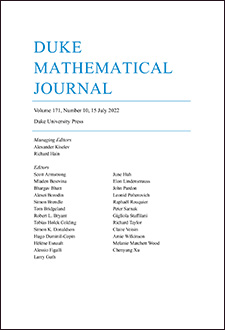Abstract
A C-dynamical system is said to have the ideal separation property if every ideal in the corresponding crossed product arises from an invariant ideal in the C-algebra. In this paper we characterize this property for unital C-dynamical systems over discrete groups. To every C-dynamical system we associate a “twisted” partial C-dynamical system that encodes much of the structure of the action. This system can often be “untwisted,” for example, when the algebra is commutative or when the algebra is prime and a certain specific subgroup has vanishing Mackey obstruction. In this case, we obtain relatively simple necessary and sufficient conditions for the ideal separation property. A key idea is a notion of noncommutative boundary for a C-dynamical system that generalizes Furstenberg’s notion of topological boundary for a group.
Citation
Matthew Kennedy. Christopher Schafhauser. "Noncommutative boundaries and the ideal structure of reduced crossed products." Duke Math. J. 168 (17) 3215 - 3260, 15 November 2019. https://doi.org/10.1215/00127094-2019-0032
Information





